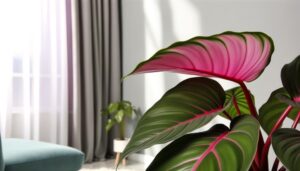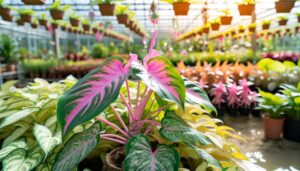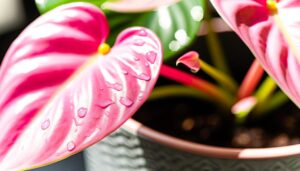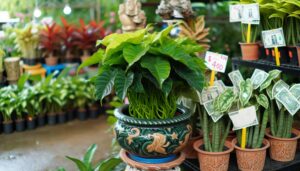What Is Philodendron Pseudo Verrucosum?
Philodendron pseudo verrucosum, a member of the Araceae family, originates from the tropical rainforests of Central and South America. It is classified under the genus Philodendron and distinguished by its intricate leaf patterns featuring deep emerald green with silvery, metallic venation.
This robust, vining plant thrives in high humidity (60%-80%), temperatures between 18°C and 27°C, and bright, indirect sunlight. Its growth habit showcases elongated internodes and the presence of aerial and adventitious roots.
Proper pest management and propagation techniques are essential for maintaining its health and vibrancy. Further insights include its exclusive variegation and best growing practices.
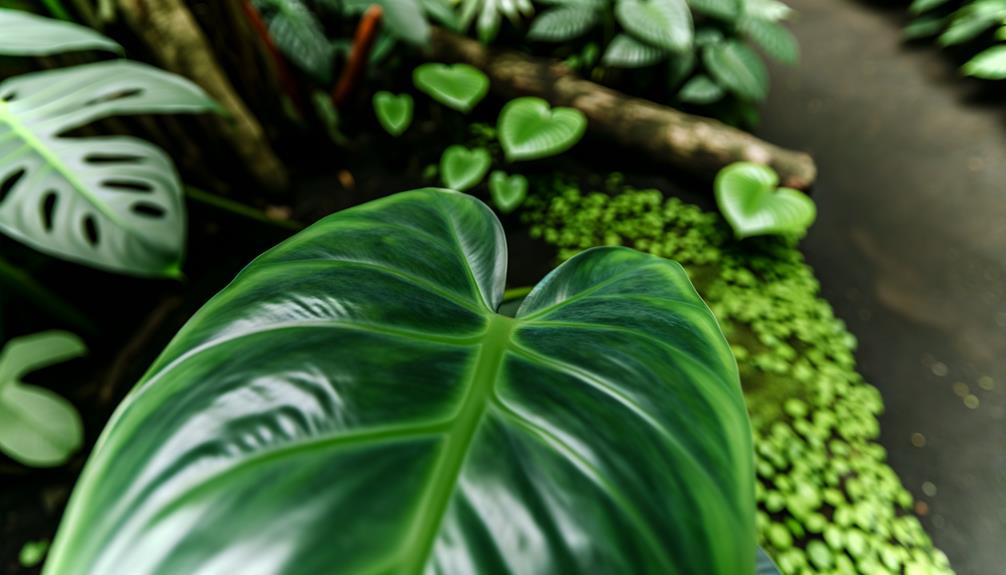
Key Takeaways
- Member of the Araceae family, originating from Central and South American tropical rainforests.
- Features distinct leaf patterns with deep emerald green, silvery veins, and a velvety texture.
- Exhibits a robust vining growth habit with elongated internodes and aerial roots.
- Prefers high humidity (60%-80%), temperatures between 18°C to 27°C, and bright, indirect sunlight.
- Requires well-draining, aerated soil and regular pest management for healthy growth.
Origins and History

Philodendron pseudo verrucosum, a member of the Araceae family, originates from the tropical rainforests of Central and South America where it thrives under the dense canopy. This species is classified under the genus Philodendron, known for its climbing and epiphytic growth habits.
Documented extensively in botanical literature, Philodendron pseudo verrucosum was first identified through field observations and herbarium specimens collected in the late 19th century. The plant's natural habitat consists of humid, shaded environments where it benefits from high humidity and stable temperatures.
Its ecological role includes functioning as a component of the rainforest understory, contributing to the biodiversity and structural complexity of its ecosystem. Historical records highlight its presence in countries such as Ecuador, Colombia, and Panama.
Unique Features
Philodendron Pseudo Verrucosum exhibits distinct leaf patterns characterized by pronounced veining and a unique blend of variegation that differentiates it from other species within the Philodendron genus.
Its growth habit showcases a robust vining structure, adapted for climbing and sprawling, which facilitates efficient nutrient acquisition and light exposure.
These morphological features contribute notably to its aesthetic appeal and ecological adaptability.
Distinct Leaf Patterns
Characterized by intricate variegation, the leaves of Philodendron Pseudo Verrucosum exhibit a distinct pattern of deep emerald green interspersed with silvery veins, contributing to its unique botanical allure.
These leaves, typically heart-shaped with pronounced lobes, display a striking contrast between the lush green primary tissue and the reflective, metallic venation. The adaxial surface is often adorned with a velvety texture, enhancing its visual appeal.
Importantly, the abaxial surface may present a slightly reddish hue, adding to its differentiation from other species. This variegation is not merely aesthetic but also indicative of its physiological adaptations.
The leaf morphology and pigmentation patterns are integral to its classification within the Araceae family, underscoring its distinctive place in botanical taxonomy.
Growth Habit Characteristics
Beyond its ornate leaf patterns, the Pseudo Verrucosum exhibits a vining growth habit, characterized by elongated internodes and robust aerial roots, which enable it to climb and anchor onto various surfaces in its native tropical habitat. This climbing behavior is facilitated by its ability to produce adventitious roots along the stem, providing structural stability and efficient nutrient uptake. The intermodal spacing allows for best light exposure, essential for photosynthesis. Unlike many philodendrons, the Pseudo Verrucosum demonstrates a unique combination of vertical and lateral growth, adapting well to varied environmental conditions.
| Characteristic | Description |
|---|---|
| Growth Habit | Vining |
| Internode Length | Elongated |
| Root Type | Aerial / Adventitious |
| Habitat | Tropical |
| Growth Orientation | Vertical and Lateral |
These features make it a versatile and resilient plant species.
Ideal Growing Conditions

Best cultivation of Philodendron Pseudo Verrucosum necessitates a meticulous balance of humidity, temperature, and light conditions to replicate its native tropical habitat. High humidity levels ranging from 60% to 80%, imitating the moist environments of rainforests, are crucial.
Temperature should be maintained between 18°C and 27°C, avoiding fluctuations that may stress the plant. Light requirements include bright, indirect sunlight; direct exposure can cause leaf scorch, while insufficient light can hinder growth and vibrancy.
Using well-draining, aerated soil mediums promotes root health, preventing waterlogging and root rot. Additionally, maintaining ambient airflow, without cold drafts, facilitates gas exchange, essential for photosynthesis and respiration.
Implementing these conditions promotes robust growth, vibrant foliar coloration, and overall plant health.
Watering and Feeding
Proper watering and feeding routines are essential for the ideal growth and development of Philodendron Pseudo Verrucosum, requiring a precise balance to avoid both dehydration and over-saturation. This species thrives in consistently moist, well-draining soil, demanding vigilant hydration without waterlogging. Employing a high-quality, well-rounded liquid fertilizer during the growing season enhances nutrient uptake efficiency and promotes vigorous foliage.
- Water thoroughly when the top inch of soil feels dry to the touch.
- Utilize distilled or rainwater to prevent mineral buildup.
- Feed bi-monthly with a diluted, balanced fertilizer (20-20-20 NPK).
- Reduce watering and feeding during the plant's dormant phase in winter.
Implementing these practices ensures robust health and peak growth, aligning with the Philodendron Pseudo Verrucosum's specific physiological requirements.
Common Pests and Issues

Philodendron Pseudo Verrucosum is susceptible to a range of common pests, including aphids, spider mites, and mealybugs, which can cause significant damage to foliage.
Disease symptoms, such as chlorosis and necrotic lesions, often indicate underlying fungal or bacterial infections.
Effective pest treatments involve targeted application of insecticidal soap and systemic fungicides, along with maintaining best environmental conditions to mitigate infestation risk.
Common Insect Infestations
Insect infestations commonly affecting Philodendron pseudo verrucosum include species such as spider mites (Tetranychidae), aphids (Aphidoidea), and mealybugs (Pseudococcidae), each presenting unique challenges to plant health and maintenance. These pests exhibit distinct behaviors and physiological impacts on the plant tissue, necessitating vigilant monitoring and management strategies.
Key infestation indicators include:
- Spider mites: Fine webbing and stippling on leaves, leading to chlorosis.
- Aphids: Presence of sticky honeydew and curled, distorted foliage.
- Mealybugs: Cottony masses on leaf axils and undersides, causing stunted growth.
- Thrips: Silvery streaks and black fecal spots on foliage, contributing to leaf deformities.
Effective pest management requires precise identification and targeted interventions to mitigate these infestations and sustain plant health.
Disease Symptoms Identification
Recognizing disease symptoms in Philodendron pseudo verrucosum involves detailed observation of foliar discoloration, necrotic spots, and abnormal growth patterns, which often indicate underlying pathogenic or environmental issues.
Chlorosis, or yellowing of the leaves, frequently suggests nutrient deficiencies or root rot. Necrotic lesions, characterized by dead, brown tissue, are commonly caused by fungal infections such as Phytophthora or Pythium species. Abnormal growth patterns, including stunted growth or leaf curling, may result from viral infections or exposure to environmental stressors like low humidity or improper lighting.
Additionally, the presence of sooty mold, a black fungal growth, can indicate an infestation of sap-sucking insects like aphids or scale, which excrete honeydew that fosters fungal proliferation.
Effective Pest Treatments
Effectively managing pest infestations in Philodendron pseudo verrucosum necessitates a thorough understanding of the common pests such as aphids, spider mites, and scale insects, along with precise identification and targeted treatment strategies. These pests can cause significant damage by feeding on the plant's sap, leading to stunted growth and leaf discoloration. Implementing integrated pest management (IPM) techniques is crucial for maintaining plant health.
- Aphids: Use insecticidal soap or neem oil for effective control.
- Spider mites: Increase humidity and apply miticides if necessary.
- Scale insects: Manually remove using a soft brush and treat with horticultural oil.
- General care: Regularly inspect plants and isolate any that show signs of infestation.
Employing these strategies ensures essential plant health.
Propagation Tips
To propagate the Philodendron Pseudo Verrucosum successfully, it is necessary to utilize stem cuttings taken from a healthy, mature plant, making sure each cutting includes at least one node and a few aerial roots. This method enhances root development and plant vigor.
| Step | Action | Description |
|---|---|---|
| 1 | Cutting Preparation | Choose a stem section with a node and roots |
| 2 | Cutting Disinfection | Sterilize tools to prevent contamination |
| 3 | Planting Medium | Use a well-draining mix (e.g., peat-perlite) |
| 4 | Environmental Conditions | Maintain high humidity and indirect light |
High humidity and indirect light are crucial during the initial rooting phase. Regular misting enhances moisture levels, while careful monitoring ensures optimal growth conditions.
Conclusion
To sum up, Philodendron pseudo verrucosum, with its uniquely textured leaves and distinct variegation, stands out as a botanical wonder deserving of detailed cultivation.
Hailing from the vibrant tropics, it thrives under particular humidity and light settings, requiring attentive care in watering and nutrient provision.
Diligence in pest control and accurate propagation methods safeguard its lush beauty.
The plant's notable traits and precise care needs add to its esteemed reputation among gardening enthusiasts and plant lovers alike.

